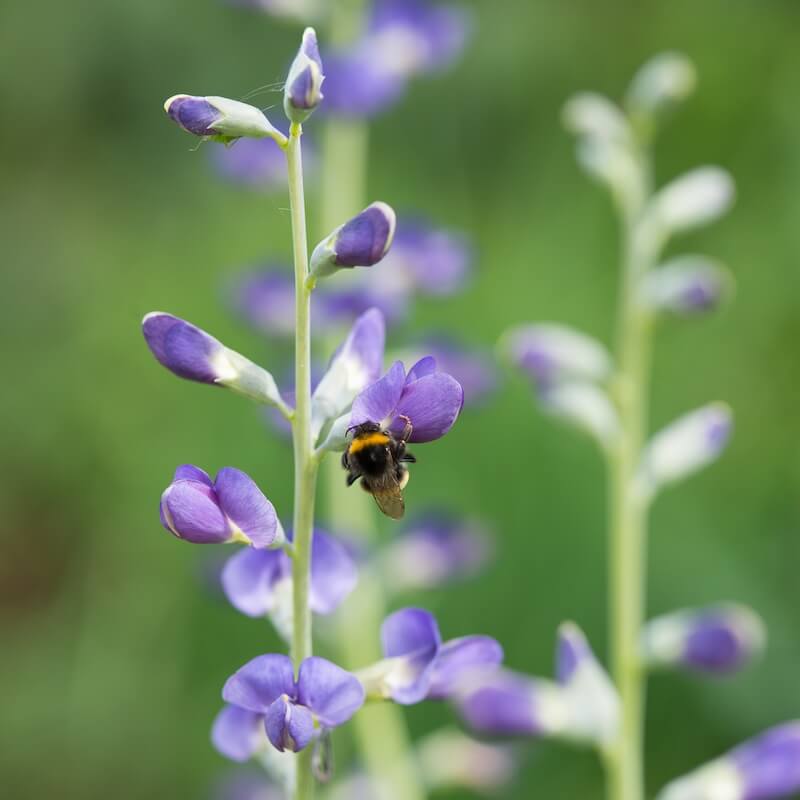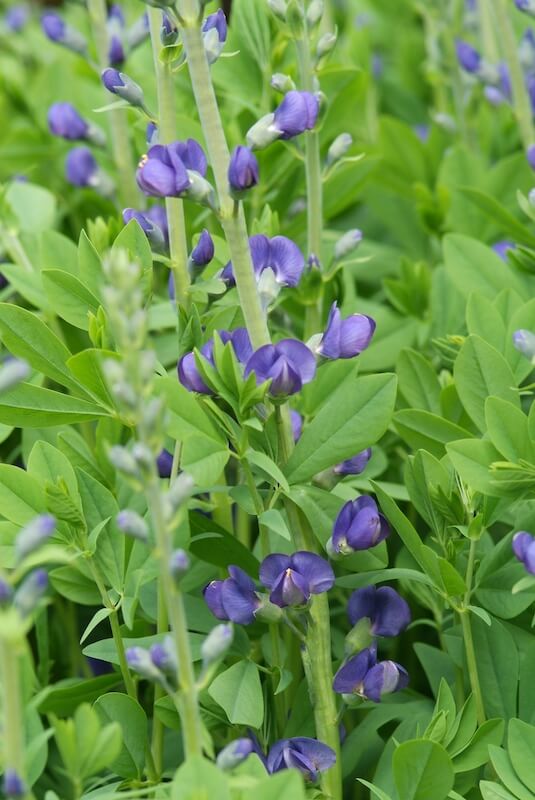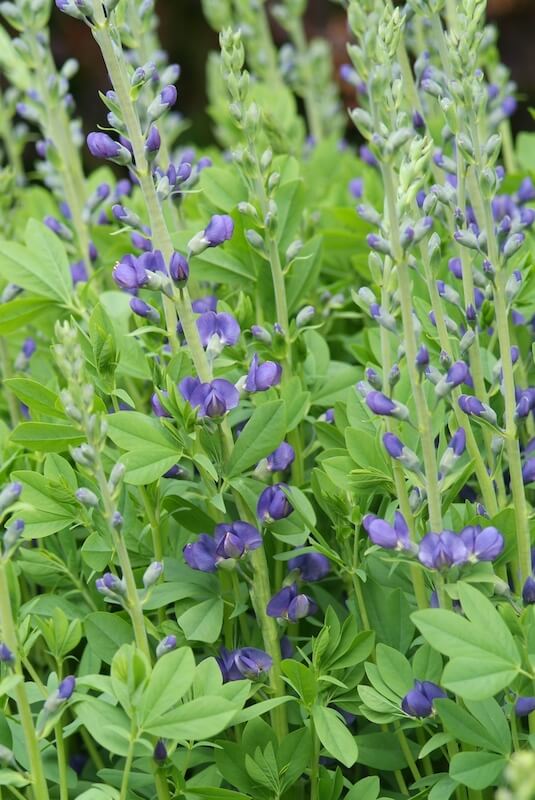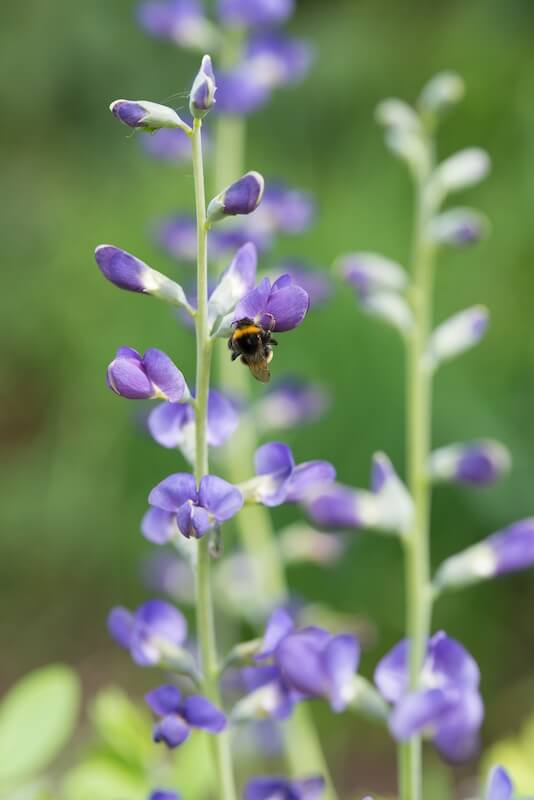Blue and Bold - Fall in Love with Baptisia australis
blue false indigo, false indigo, false lupine, golden indigo, indigo weed, tall false indigo, rattleweed, Baptisia confusa, Baptisia minor, Baptisia caerulea, Baptisia versicolor

Position
- Prefers a sunny, well-lit spot for best flowering; tolerates light afternoon shade
- Ideal for mixed, gravel or prairie-style borders and wildflower meadows
- Needs shelter from cold, drying winds to protect flower spikes
Hardiness
- Withstands winter lows down to about –20 °C (–4 °F)
- Very reliable throughout the UK; benefits from a light mulch in exposed gardens
Soil
- Thrives in deep, well-drained, moderately fertile soil
- At planting, improve heavy or poor soils with plenty of compost; avoid waterlogged conditions
- Drought-tolerant once established, provided drainage is good
- Adapts to acid, neutral or alkaline soils
- Performs best where organic matter keeps moisture even and soil structure open
- Grab a soil test kit and ensure the perfect conditions for growth
Height
- Typically reaches 90–120 cm (3–4 ft) tall
- Spreads to form a broadly upright clump of stout, bushy stems
Seasons of Interest
- Foliage: Fresh green, trifoliate leaves from spring to autumn, turning soft yellow before dying back
- Autumn Colour/Variegation: Foliage takes on a gentle yellow hue in autumn; no variegation
- Flowering: Arching spikes of pea-like, pale blue-violet flowers appear in May and June, lasting 4–6 weeks
Additional Notes
- Divide very sparingly; plants resent disturbance—best left undisturbed once established
- Cut back spent stems to ground level after foliage dies to tidy the clump
- Mulch in spring with compost to conserve moisture and support new growth
- Attracts bees and other pollinators—excellent for wildlife gardens
- Avoid over-rich soils, which can lead to floppy growth; moderate fertility gives the best structure
- Seedpods may self-sow; remove spent flowers if self-seeding is not desired
Why Gardeners are Buzzing About Baptisia australis
Baptisia australis, also known as false indigo, brings bold structure and rich blue blooms to any garden. This plant has earned the prestigious Award of Garden Merit (AGM) from the Royal Horticultural Society thanks to its reliable performance. It offers striking, pea-like blue flowers in early summer, forming deep, rich-coloured spikes that draw attention.
What is Baptisia australis and why is it so admired?
Baptisia australis is a bold and upright plant native to central and eastern North America. This plant produces tall flower spikes adorned with indigo blue flowers in early summer. The flower spikes rise above dense clumps of grey-green foliage, creating a stately appearance in borders and meadows. False indigo has long been valued for its ornamental impact, drought tolerance, and low-maintenance nature.
Gardeners admire Baptisia australis because its pea-like flowers resemble those of lupin, yet this species is far more robust. Following blooms, it produces seed pods that rattle in the wind, adding autumn and winter interest. The plant attracts attention from pollinators and adds structural form even after flowering. It’s both attractive and durable, making it an excellent choice for borders, wildflower areas, and cottage garden schemes.
What is the plants background?
Baptisia belongs to the Fabaceae family and was historically used by Native Americans as a source of blue dye. The plant’s common names, “false indigo” or “wild indigo,” reflect its similarity to true indigo plants. Among its additional common names are indigo weed and rattleweed, thanks to its loose seeds in mature pods. Its trifoliate leaves and upright form make it distinct within the genus.
Because of its long tap root, the Baptisia australis plant resists transplanting trouble and thrives in undisturbed sites. It earned the Royal Horticultural Society’s attention early on due to its striking form and longevity. Many gardeners refer to it affectionately as blue wild indigo or blue false indigo, underlining its remarkable bloom and foliage combination.
Is Baptisia australis easy to grow in a garden?
Yes, Baptisia australis is a plant that ranks among the easiest to grow perennials for sunny gardens. It requires little fuss once established, forming a deep tap root that resists disturbance. The plant forms a neat clump of foliage, which helps suppress weeds and reduces maintenance demands. Gardeners can rely on its consistent performance year after year.
Plant in well-drained soil and avoid waterlogged conditions. A sunny location encourages more substantial flower spikes in early summer. While it tolerates poor soil, adding organic matter at planting ensures better establishment and bloom production. This plant shines especially in mixed borders, meadow edges, and even as a specimen in larger pots.
How does the plant perform as a perennial?
As a perennial, Baptisia australis provides long-lasting structure and presence. Once planted, it returns reliably each year, with mature specimens often lasting decades. Its leaves die back to the ground in autumn after frost and winter cold. The early spring reshoot emerges fresh, encouraging a long growing season of interest.
The foliage remains appealing even before bloom, and the erect stems add vertical height to planting schemes. Bloom lasts through early summer, followed by decorative seed pods that remain through autumn. Gardeners find that this plant fills a niche as a low-maintenance, high-impact perennial.

What kind of soil suits false indigo best?
Baptisia australis thrives in well-drained soil, ideally enriched with compost to aid in initial growth. The plant tolerates poor, lean soils, but it also resists waterlogging; therefore, avoid planting it in areas with poor drainage. Clay soils require amending with organic matter to prevent sogginess, especially in winter.
Once the plant establishes its roots, it tolerates drought well due to its deep root system. Its deep tap root enables access to moisture lower in the soil profile. Avoid overly rich soils that remain wet, as this can lead to root issues. A sunny bed with moderate fertility and good drainage gives the best results for bloom and longevity.
How does it bloom and produce seed pods?
In early summer, Baptisia australis unfolds striking racemes of blue false indigo blooms. These pea‑like flowers cluster densely on upright stems, creating a bold blue statement. The bloom phase can last several weeks, offering a steady display in the garden.
Following the blooms, the plant forms pod-like seed pods that inflate and harden into rattle pods. In autumn, these pods dry and release their seeds, which rattle in the wind. They add textural interest through late season and into winter. Many gardeners allow pods to persist for winter interest or to collect seeds for propagation.
Are the plant’s seed pods and seeds toxic?
Yes, parts of Baptisia australis, particularly the seeds in mature pods, are toxic. The plant has a purgative effect if ingested in large amounts and can cause vomiting. The Cherokee and Osage once used the Baptisia australis plant in traditional medicinal practices, such as an eyewash or cold tea. However, misuse led to adverse effects. As such, children and pets should not consume seeds or foliage from these plants.
Despite the plant’s ornamental appeal, it’s vital to handle seed pods responsibly. Avoid sowing seed near pets or play areas. While it offers many benefits to pollinators, toxicity remains part of its history and usage.
How does Baptisia australis handle drought and frost?
This plant has excellent drought tolerance once established. The deep tap root allows it to thrive in dry conditions, meaning moderate drought does not affect bloom quality. In contrast, excess moisture or waterlogged soil can harm roots. Balanced soil moisture helps maintain plant health through summer.
Baptisia australis stands up well to frost. It is hardy in most climates and handles early spring cold snaps with ease. Frost simply causes the deciduous foliage to die back in autumn. Gardeners can leave the foliage and pods through winter for added interest, or tidy up before spring’s new growth begins.

Can wild indigo be propagated from seed?
Yes, you can sow Baptisia australis seed, though patience is key. Seeds tend to germinate slowly and may take two seasons to bloom. Cold treatment, also known as stratification, helps improve germination rates. Sow seeds in pots in autumn or early spring in well-drained potting mix.
Rather than sowing wild outdoors, start in a pot to ensure good drainage and protection from competition. Transplant seedlings only after they develop several true leaflets and grow strong roots. Expect flowering in the second or third year. Division of mature clumps is possible but not common due to the deep tap root.
Why did Baptisia australis earn an Award of Garden Merit?
The RHS awarded Baptisia australis the Award of Garden Merit because it excels in ornamental performance, reliability, and low maintenance. The plant produces dramatic flower spikes, a year-round structure, and exceptional drought and frost tolerance. It thrives in sunny spots and flourishes in a range of soils.
Gardeners value its long-lasting bloom, architectural form, and minimal care requirements. False indigo enhances biodiversity by attracting bees and beneficial insects. As a native species with a long history of use, it combines beauty with resilience. These combined traits earn it the prestigious AGM rating.
From Darren’s Patch
Baptisia australis is one of those plants I admire from afar—its upright elegance, deep indigo flowers and sheer resilience make it a standout in any garden. I don’t have it in the ground here at the moment, but it’s firmly on my watchlist. What I love most is how it quietly delivers impact without demanding much in return. Once it settles in, it just gets better with age—no fuss, no drama. The rattle of those seed pods in autumn is a subtle delight, adding a touch of whimsy and texture to the border. If you’ve got a sunny, well-drained spot that doesn’t get disturbed much, this is a perennial that will reward your patience many times over. It’s the sort of plant that quietly earns its keep—and then some.
![]()
Key Points to Remember
- Baptisia australis, or false indigo, offers indigo blue pea‑like flower spikes in early summer
- This perennial thrives in full sun with well‑drained soil enriched by compost
- Its upright stems and grey-green foliage add structure long before bloom
- After flowering, the seed pods rattle through autumn and early winter
- The plant has toxicity in seeds and pods—handle with caution around children and pets
- It tolerates drought and frost, thanks to its deep tap root and hardy nature
- Sow seeds after stratification or propagate by division, though the root is deep
- Gifted the AGM by RHS for its ornamental impact, reliability, and ease of care
- Works well in meadows, borders, and wildflower gardens with minimal maintenance
- Ideal choice for gardeners seeking structural form, soft colour and year‑long interest
With its bold presence, durable character and minimal demands, Baptisia australis stands out as perhaps the best-known blue perennial for sunny gardens. It combines resilience with refined beauty, making it a worthy investment for gardeners.
Check out the RHS article here.
If you like this one, you’ll love Brunnera Jack Frost. Click here to explore it.
For more information on perennials for your garden, please click here.

Frequently Asked Questions
Q: What is Baptisia australis, and why is it called false indigo?
A: Baptisia australis, commonly known as false indigo or blue false indigo, is a hardy herbaceous perennial from the Fabaceae genus, native to central and eastern North America. It produces striking, indigo-blue flowers in upright racemes during early summer. It has been historically used as a substitute for true indigo dye—hence the name “false indigo.” It is tolerant of dry spells once established, thanks to its deep taproot. This ornamental plant is admired for its elegant trifoliate leaves, drought tolerance, and ability to form an attractive, shrub-like clump. Its other common names include blue wild indigo and wild indigo, reflecting its natural habitat in North American meadows and prairies.
Q: Is Baptisia australis easy to grow in a UK garden?
A: Yes, Baptisia australis is easy to grow and well-suited to UK gardens, particularly in sunny, well-drained positions. It thrives in full sun and moderately fertile soil and is tolerant of dry spells once established, thanks to its deep tap root. This perennial is ideal for cottage gardens, wildlife borders, or naturalistic planting schemes. Although it starts slowly, once settled, the plant is remarkably long-lived and best left undisturbed. In time, it forms a dense clump of grey-green foliage topped with lupin-like blue flowers in early summer, making it an excellent structural and low-maintenance addition to any garden.
Q: How tall does Baptisia australis grow, and what does it look like?
A: Baptisia australis typically reaches around 90–120cm in height and spreads up to 90cm wide. It grows from a woody crown with erect stems that support loose spikes of indigo blue, pea-like flowers in early summer. The trifoliate leaves are grey-green and remain attractive throughout the season. After flowering, the plant develops inflated, black seed pods that rattle when shaken—adding further ornamental interest well into autumn. This upright perennial has a bold, architectural quality, often compared to lupins or other members of the pea family, and is ideal for adding height and texture to mixed borders.
Q: What type of soil and site does Baptisia australis prefer?
A: Baptisia australis performs best in well-drained soil with moderate fertility. While it is tolerant of poor, dry soils and drought once established, it dislikes waterlogged conditions. Choose a site in full sun to encourage vigorous flowering and sturdy growth. Select a site in full sun to promote vigorous flowering and robust growth. It will tolerate light shade, but flowering may be reduced. Because of its deep tap root and dislike of disturbance, it’s wise to choose the planting location carefully. This hardy perennial is ideal for sunny borders, gravel gardens, and wildflower-style meadows, where it can remain undisturbed and develop into a substantial, long-lasting plant.
Q: Is Baptisia australis toxic to humans or pets?
A: Yes, Baptisia australis is considered mildly poisonous if ingested. All parts of the plant contain compounds that can cause vomiting or purgative effects in humans and animals. Historically, parts of the plant were used medicinally by Indigenous peoples, but such uses are not recommended without professional guidance. Although it is not a common hazard in gardens, it’s best to keep pets and young children from eating any part of the plant. Its seed pods and foliage are not typically appealing to animals, and the plant’s toxicity does not affect its ornamental value.
Q: Does Baptisia australis attract wildlife to the garden?
A: Yes, Baptisia australis is a valuable wildlife plant. Its early summer bloom attracts a wide range of pollinators, including bees and butterflies, which are drawn to the pea flowers’ nectar and pollen. The plant’s loose seeds are also enjoyed by birds in late summer and autumn, adding further biodiversity value. As a low-maintenance, drought-tolerant perennial, blue false indigo supports healthy ecosystems in both formal and naturalistic garden settings. Its long season of interest—from flowers to rattling seed pods—also provides shelter and visual structure throughout the growing season.
Q: Can Baptisia australis be grown in pots?
A: While it is possible to grow Baptisia australis in a deep pot, it is not ideal. The plant forms a long tap root, which makes it better suited to open ground where it can develop undisturbed. If grown in containers, choose one that is very deep and use a well-drained, gritty compost mix. Be prepared for slower growth, and feed lightly in spring with a balanced, slow-release product. Container-grown plants will also need more regular watering in dry weather. For best long-term results, it is recommended to grow Baptisia australis directly in the garden.
Q: How do I propagate Baptisia australis from seed or division?
A: While Baptisia australis can be propagated from seed, patience is required. Sow seeds in autumn or early spring in cold frames. Seeds may benefit from scarification to break dormancy. Germination is slow, and seedlings may take several years to flower. Division is more challenging due to the plant’s deep taproot and its aversion to disturbance. If attempted, it’s best done in early spring on younger clumps. However, propagation from seed remains the most reliable and least disruptive method. Once established, plants will self-seed modestly without becoming invasive, and the dried flower pods can also be collected for sowing.
Q: When does Baptisia australis flower, and how long does it bloom?
A: Baptisia australis typically blooms in early to mid-summer, with its indigo blue flower spikes appearing from late May through June. The bloom period lasts approximately 3–4 weeks, depending on the weather conditions. These upright, lupin-like spikes of pea flowers rise above the foliage and make a striking display. After flowering, the plant forms decorative seed pods that persist into autumn, extending its season of interest. While the flowering period is relatively brief, the plant’s elegant foliage remains attractive throughout the summer, adding texture and a sense of structure to the perennial border.
Q: Where can I buy Baptisia australis in the UK?
A: Baptisia australis is widely available in the UK and can be purchased from reputable garden centres, specialist perennial nurseries, and online plant retailers. It is often listed under the common names blue false indigo or wild indigo, and may also appear in RHS-recommended selections due to its award of garden merit (AGM). When buying online, choose well-rooted young plants or plug plants in spring for the best results. Many growers also offer seeds for those who wish to propagate their plants.
